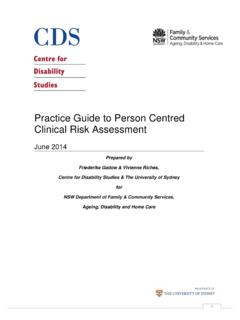Transcription of Guide six steps to risk management - NT WorkSafe
1 GuideSix step to risk managementVersion: date: September 2018 DisclaimerThis publication contains information regarding work health and safety. It includes some of your obligations under the Work Health and Safety (National Uniform Legislation) Act the WHS Act that NT WorkSafe administers. The information provided is a Guide only and must be read in conjunction with the appropriate legislation to ensure you understand and comply with your legal Guide is based on material produced by WorkSafe ACT at management Hazard and approach to the management of Hazards and associated 1: Hazard of 2: Risk of risk 3: Risk key 4: Risk Control 5: Documenting the 6: Monitoring and Guide aims to help you assess and manage health and safety risks in the management is an important way to protect your workers and your business, while at the same time complying with the law.
2 It helps you focus on the risks that really matter in your workplace the ones with the potential to cause real harm. In many instances, straightforward measures can readily control risks , for example ensuring spillages are cleaned up promptly so people do not slip, or cupboard drawers are kept closed to ensure people do not trip. For most, that means simple, cheap and effective measures to ensure your most valuable asset your workforce is law does not expect you to eliminate all risk, but you are required to protect people as far as reasonably practicable . This Guide will help you to achieve steps outlined in this Guide are not the only way to conduct a WHS risk management process, there are other methods that work well, particularly for more complex risks and circumstances. However, we believe this method is the most straightforward for most t overcomplicate the process.
3 In many organisations, the risks are well known and the necessary control measures are easy to apply. If you are an employer, you probably already know whether, for example, you have employees who move heavy loads and so could harm their backs, or where people are most likely to slip or trip. If so, check that you have taken reasonable precautions to avoid injury. If you run a small organisation and you are confident you understand what s involved, you can do the assessment yourself. You don t have to be a health and safety expert. If you work in a larger organisation, you could ask a health and safety advisor to help you. If you are not confident, get help from someone who is competent. In all cases, you should make sure that you involve your staff or their representatives in the process. They will have useful information about how the work is done that will make your assessment of the risk more thorough and effective.
4 But remember, you are responsible for seeing that risk management is carried out management practiceRisk management is recognised as an integral part of good management practice. It is an interactive process consisting of steps , which, when undertaken in sequence, enable continual improvement in decision making. Risk management is the term applied to a logical and systematic method of establishing the context, identifying, analysing, treating, monitoring and communicating risks associated with any activity, function or process in a way that will enable organisations to minimize losses and maximize opportunities. Risk management is as much about identifying opportunities as avoiding or mitigating Hazard and RiskHazards and risks are not the same thingA hazard is an act or condition that has the potential to cause damage to plant or equipment, or result in an illness or injury.
5 Hazards can be categorised by the type of outcome, energy exchange process or geographic location, manual handling hazards, slips and trips, laundry hazards. A risk is the likelihood of a specific consequence occurring. risks are usually expressed in terms of likelihood and consequences the risk of contracting Ross River Fever while working in Tasmania might be considered to be very many cases the terms hazard and risk are used interchangeably, however, remember that hazard has a more general application and risk a specific application. Risk management has three (3) main stages, risk identification, risk assessment and risk control. In many cases in the early phase of identifying risk, we may in fact be looking to identify all the risks associated with a particular activity or process, in which case the activity is more properly referred to as hazard identification, risk assessment and then risk approach to the management of Hazards and associated RisksThe aim of the process is to minimise the likelihood or consequence of a particular risk to a level that is minimal and that we are prepared to accept.
6 The risk management process includes: Identification of a hazard Identification of the associated riskAssessment of the risk including: the likelihood the consequence assigning a priority for rectificationControl of the risk using a hierarchy of control measures consisting of the following in order of preference: Elimination Substitution Isolation Engineering controls Administrative controls (such as Standard Operating Procedures or training) Personal Protective Equipment (PPE) Documentation of the process Monitoring and review of the process6 Step 1: Hazard identificationThis is the process of examining each work area and work task for the purpose of identifying all the hazards which are inherent in the job . Work areas include (but are not limited) to machine workshops, laboratories, office areas, agricultural and horticultural environments, stores and transport, maintenance and grounds.
7 Tasks can include (but may not be limited to) using screen based equipment, audio and visual equipment, industrial equipment, hazardous substances and/or dangerous goods, teaching/dealing with people, driving a vehicle, dealing with emergency situations, construction, you need to work out how people could be harmed. When you work in a place every day it is easy to overlook some hazards, so here are some tips to help you identify the ones that matter: Walk around your workplace and look at what could reasonably be expected to cause harm Ask your employees or their representatives what they think. They may have noticed things that are not immediately obvious to you Visit the NT WorkSafe website or other work health and safety websites as they often publish practical guidance on where hazards occur and how to control them. If you are a member of a union or trade association, contact them.
8 Many produce very helpful guidance in this area Check manufacturers instructions or data sheets for chemicals and equipment, as they can be very helpful in spelling out the hazards and putting them in their true perspective Have a look back at your accident and ill-health records these often help to identify the less obvious hazards Remember to think about long-term hazards to health ( high levels of noise or exposure to harmful substances) as well as safety of Hazards an unguarded gear wheel on a workshop grinding machine which has the potential to draw a worker s clothing and limbs into the drive of the machine and cause serious bodily injury handling of flammable liquids in the presence of ignition sources an unlabelled container of caustic soda which has the potential to cause severe skin burns if handled incorrectly providing services to the public which involve the granting or withholding of some benefit or service driving of motor vehicles or other powered equipment onsite loose asbestos released during demolition work noise from an uninsulated chainsaw which can reach levels of up to 110 dB with the potential to seriously damage hearing7 a badly designed shovel (for example, with a short handle and a very large blade)
9 Which has the potential to cause back injury waste oil from an engine which can damage workers health through skin absorption or be a possible cause of slips or falls blood in a syringe at a hospital, which has the potential to infect a worker with a disease if the needle punctures the worker s that workplace hazard identification, assessment and control is an on-going process which is best conducted in the context of full consultation between an employer and their employees. It should be undertaken at various times, including: if it has not been done before when a hazard has been identified when a change to the workplace occurs after an incident, accident or workplace illness at regularly scheduled times appropriate to the process of hazard identification can also assist in: revealing hazards which were overlooked in the original design and installation of plant, equipment, operating procedures and setting-up of associated work systems detecting hazards which have developed after the plant, equipment, other resources (chemical etc.)
10 Or work system has been established highlighting any ergonomic problems associated with the plant, equipment, operating procedures indicating any environmental factors poor lighting, that may contribute to an accident determining methods for ongoing monitoring to achieve optimum WHS standards highlighting any training 2: Risk identificationExamples of risk identificationHazard: Frayed wires on electrical items Risk: Operator may be electrocuted Hazard: Unguarded rollers on printing machine Risk: Operator s hand may be drawn in and crushedOnce a hazard to health and safety has been identified, the risk associated with that hazard must be examined. As a prelude to Risk assessment , it is useful to identify factors that may be contributing to the risk. A review of existing health and safety information, such as local workplace accident records and / or information about the hazard / risk that is available from national or other jurisdiction authoritative sources will assist in understanding the risk associated with the hazard in 3: Risk assessmentTwo key factorsIt is then necessary to evaluate the likelihood of an injury occurring along with its probable consequences.





